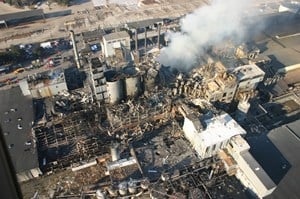 The 2008 Imperial Sugar plant combustible dust explosion was an industrial accident that changed the conversation about worker safety and created a need for updated legislation. The explosion fatally injured 14 workers, severely injured many more, and destroyed most of the factory building.
The 2008 Imperial Sugar plant combustible dust explosion was an industrial accident that changed the conversation about worker safety and created a need for updated legislation. The explosion fatally injured 14 workers, severely injured many more, and destroyed most of the factory building.
What happened that day that caused plain sugar to explode so catastrophically in a plant that operated without incident for so long beforehand?
After investigating the sugar dust explosion and releasing a detailed report of what caused the combustion the Chemical Safety Board has created the following video outlining the events that led to that fateful day:
(Original Link Found Here)
The Cause of the Sugar Dust Explosion:
According to the report, the machinery used to process the sugar was not well-kept and would spill sugar onto the floor and surrounding areas, often building up to knee deep. Workers would use compressed air to clean the floors of loose sugar dust, which just caused it to accumulate in high places such as rafters, beams, light fixtures and inside ventilation ducts. There were dust collectors, but these were not regularly cleaned and maintained, and were too small to handle the amount of dust created.
In a tunnel underneath the silos used to store the sugar, a steel conveyor belt was used to transport sugar. This conveyor belt regularly became blocked by clumps of sugar, which would then spill sugar dust onto the floor. In 2007 the company decided to enclose this conveyor belt in steel sheets to prevent contamination, but this took away the ventilation that cleared dangerous accumulations of sugar dust from the tunnel.
The first explosion took place inside this enclosed conveyor belt, when a blockage caused a buildup of sugar dust and an overheated bearing created an ignition spark. This sugar dust explosion traveled throughout the building, causing numerous other explosions as the accumulated dust became airborne and ignited. The explosion was powerful enough to buckle the building’s concrete floors, sending the accumulated dust on the floor into the air, as well as knocking high area dust down.
Scarily, the management at Imperial Sugar knew all about the sugar dust explosion risk, yet did nothing to prevent this catastrophe from happening. Their lack of preparation has caused new legislation to be created to manage combustible dust hazards, and OSHA has labelled combustible dust one of their top priorities in the upcoming years.

